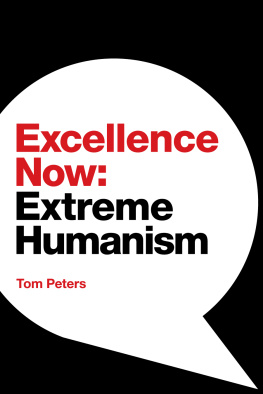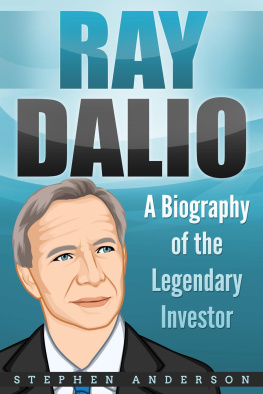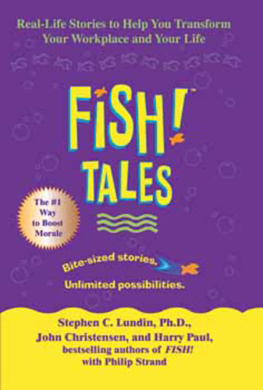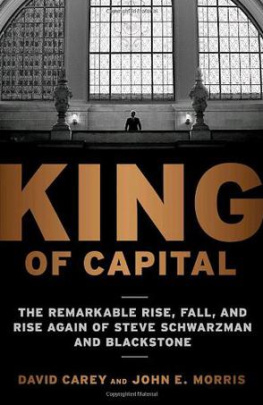First published in the United States by Avid Reader Press,
an imprint of Simon & Schuster, Inc., 2019
First published in Great Britain by Simon & Schuster UK Ltd, 2019
A CBS COMPANY
Copyright Stephen A. Schwarzman, 2019
The right of Stephen A. Schwarzman to be identified as the author of this work has been asserted in accordance with the Copyright, Designs and Patents Act, 1988.
Simon & Schuster UK Ltd
1st Floor
222 Grays Inn Road
London WC1X 8HB
www.simonandschuster.co.uk
www.simonandschuster.com.au
www.simonandschuster.co.in
Simon & Schuster Australia, Sydney
Simon & Schuster India, New Delhi
The author and publishers have made all reasonable efforts to contact copyright-holders for permission, and apologise for any omissions or errors in the form of credits given.
Corrections may be made to future printings.
A CIP catalogue record for this book is available from the British Library.
Hardback ISBN: 978-1-4711-8955-5
eBook ISBN: 978-1-4711-8956-2
MADE, NOT BORN
I n spring 1987, I flew to Boston to meet with the endowment team at the Massachusetts Institute of Technology. I was trying to raise money for Blackstones first investment fund and had set a target of $1 billion. This would make us the biggest first fund of our kind and the third biggest in the world. It was an ambitious goal. Most people said it was impossible. But Ive always believed that its just as hard to achieve big goals as it is small ones. The only difference is that bigger goals have much more significant consequences. Since you can tackle only one personally defining effort at a time, its important to pursue a goal that is truly worthy of the focus it will require to ensure its success.
Countless rejections later, though, I was starting to panic.
Pete Peterson and I had started Blackstone in 1985 with high hopes and a carefully conceived strategy. But business hadnt been coming in at anything like the rate we had planned. We had gone from the pinnacle of Wall Street at Lehman Brothers, a famous investment bank where Pete was chief executive and I had run the worlds busiest mergers and acquisitions department, to objects of potential ridicule. If we couldnt raise this money, it would call our entire business model into question. Our former rivals were hoping we would fail, and I was worried they might be right.
I confirmed our appointment at MIT the day before and arrived on Massachusetts Avenue with Pete, ready to talk about our plans and get a commitment. We found a door with a frosted window, marked MIT Endowment, and knocked. No answer. We knocked again, then a third and fourth time. I checked my schedule to make sure we were in the right place. Pete, who at sixty-one was twenty-one years older than me and had been commerce secretary under President Nixon before joining Lehman, stood behind me looking unamused.
Finally, a passing janitor saw us and stopped. We told him we were there to see the people at the endowment fund.
Oh. Its Friday. They left a while ago, he said.
But we have a 3:00 p.m. appointment, I said.
I saw them leave. Theyll be back on Monday morning.
As Pete and I left with our heads down and shoulders slumped, it began to rain. We were unprepared for the weather, without a raincoat or umbrella, so we stood at the exit to MITs administration building, hoping to wait it out. Twenty minutes later, it was pouring harder.
I had to do something. I left Pete and ran into the street to try to hail a taxi. In no time, the rain soaked through my jacket and shirt straight to my skin. My clothes were hanging off me like rags, the water streaming into my eyes and down my face. Every time I thought I finally had a taxi, someone else grabbed it before me. Desperate and drenched, I spotted a cab sitting at a red light and ran over to it. I banged on the back window and held up a limp twenty-dollar bill, hoping the bribe would be enough for the passenger to let us get in with him. He stared at me through the glass. I must have looked bizarre, hammering on the window in my sopping wet suit. He refused. Two more people did the same. I raised my offer to thirty dollars and finally someone accepted.
It was the closest to a deal I had gotten in weeks.
I waved Pete over and he began slowly walking toward me, wetter and grumpier with every step. His full head of hair was pasted to his head as if he were standing in the shower. Pete was used to having cars waiting for him, drivers holding umbrellas as he got in and out. But a year and a half before, he and I had decided to start a business together. And from the look on his face as he walked through the puddles, I could tell he regretted it.
It hadnt been that long ago that Pete and I could call anyone in Corporate America or in governments around the world and find a receptive audience. Neither of us imagined starting a business would be easy. Nor did we envision being slumped in our seats at Logan Airport on a Friday night, soaked to our skins, without a dollar to show for our efforts.
Every entrepreneur knows the feeling: that moment of despair when the only thing you are aware of is the giant gap between where you find yourself and the life and business you imagine. Once you succeed, people see only the success. If you fail, they see only the failure. Rarely do they see the turning points that could have taken you in a completely different direction. But its at these inflection points that the most important lessons in business and life are learned.
In 2010, Drew Faust, then president of Harvard, came to see me in New York. We spoke about a lot of things, but spent most of our time talking about running large organizations. When she retired from Harvard in 2018, she found the lengthy notes she had taken at our meeting and sent them to me. Among the many things she jotted down, one stood out: The best executives are made, not born. They absorb information, study their own experiences, learn from their mistakes, and evolve.
I certainly did.
Not long after I saw Drew, I had a conversation with Hank Paulson, the former US treasury secretary and chief executive of Goldman Sachs, who suggested I go over my old calendars, record my thoughts on building and managing an organization, and have them transcribed in case I might someday want to publish them. He thought my experiences and lessons would be of interest to a much wider audience. I took him up on his suggestion.
I regularly speak to audiences of students, executives, investors, politicians, and people at nonprofit organizations. The most frequent questions I get are about how we built, and now manage, Blackstone. People are fascinated by the process of imagining, starting, and growing an organization and creating a culture that attracts highly talented people. They also want to know what kind of person takes on such a challengewhat traits, values, and habits this person must have.
I never wanted to write a memoir chronicling every moment of my life. I never considered myself worthy enough. Instead I decided to pick events and episodes where I learned something important about the world and my work in it. This book is a collection of some of the inflection points that led to who I am today and the lessons they taught me, which I hope will be useful to you.
I grew up in the middle-class suburbs of Philadelphia, absorbing the values of 1950s America: integrity, straightforwardness, and hard work. My parents had never given me any money beyond my allowance, so my brothers and I had to earn our own. I worked in my familys linens store, sold candy bars and lightbulbs door-to-door, delivered telephone books, and started a lawn-mowing service with two part-time employeesmy younger twin brothers. They got half the revenue for doing the work, and I kept the other half for securing clients. The business lasted three full years before we had an employee strike.









